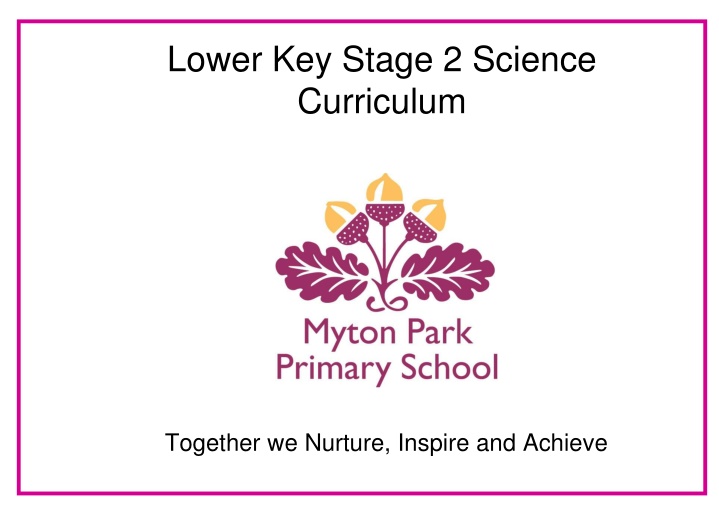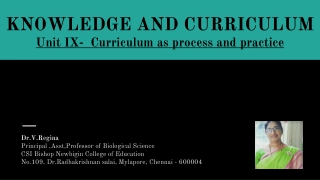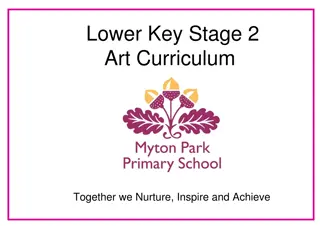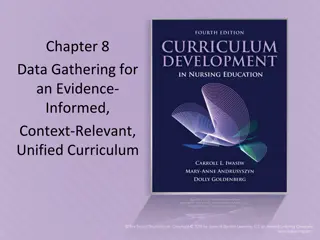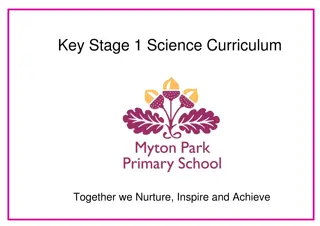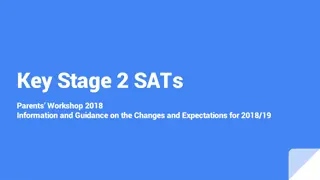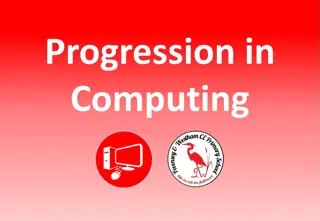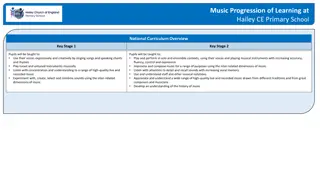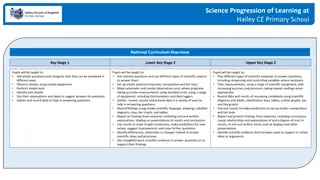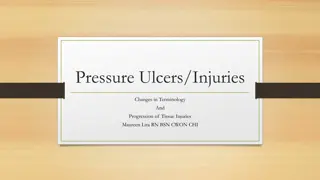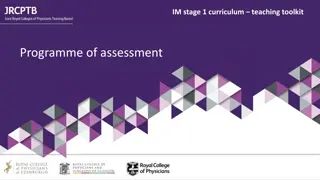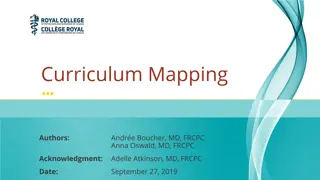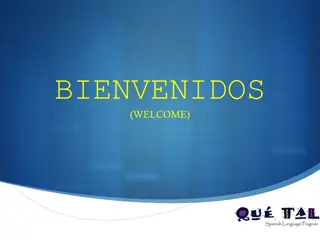Lower Key Stage 2 Science Curriculum Progression
Progression and expectations in Lower Key Stage 2 Science Curriculum focusing on working scientifically, observations, measurements, data gathering, and scientific inquiries. Topics include plant functions, rock properties, water transport in plants, and more.
Download Presentation

Please find below an Image/Link to download the presentation.
The content on the website is provided AS IS for your information and personal use only. It may not be sold, licensed, or shared on other websites without obtaining consent from the author.If you encounter any issues during the download, it is possible that the publisher has removed the file from their server.
You are allowed to download the files provided on this website for personal or commercial use, subject to the condition that they are used lawfully. All files are the property of their respective owners.
The content on the website is provided AS IS for your information and personal use only. It may not be sold, licensed, or shared on other websites without obtaining consent from the author.
E N D
Presentation Transcript
Lower Key Stage 2 Science Curriculum Together we Nurture, Inspire and Achieve
Science: Working Scientifically This table shows the progression across the Milestones and the expectations to be incorporated into planning at Milestone 2 Milestone 2 Milestone 3 Milestone 1 Ask relevant questions. Set up simple, practical enquiries and comparative and fair tests. Making systematic and careful observations and where appropriate make accurate measurements using standard units, using a range of equipment, e.g. thermometers and data loggers. Gather, record, classify and present data in a variety of ways to help in answering questions. Record findings using simple scientific language, drawings, labelled diagrams, bar charts and tables. Report on findings from enquiries, including oral and written explanations, displays or presentations of results and conclusions. Use results to draw simple conclusions and suggest improvements, new questions and predictions for setting up further tests. Identify differences, similarities or changes related to simple, scientific ideas and processes. Use straightforward, scientific evidence to answer questions or to support their findings. Plan enquiries, including recognising and controlling variables where necessary. Take measurements, using a range of scientific equipment, with increasing accuracy and precision, take repeat readings where appropriate. Record data and results of increasing complexity using scientific diagrams and labels, classification keys, tables, bar and line graphs, and models. Report findings from enquiries, including oral and written explanations of results, explanations involving causal relationships, and conclusions. Present findings in written form, displays and other presentations. Use test results to make predictions to set up further comparative and fair tests. Use simple models to describe scientific ideas, identifying scientific evidence that has been used to support or refute ideas or arguments. Ask simple questions and recognising they can be answered in different ways. Observe closely, using simple equipment. Perform simple tests. Identify and classify. Use observations and ideas to suggest answers to questions. Gather and record data to help in answering questions.
Science: Autumn Term This table shows the knowledge that will be taught in each lesson Year 4 Year 3 Milestone Describe and Illustrate the functions of different parts of flowering plants. Explain how leaves are important in creating food for a plant. Prove or disprove that roots act like straws sucking up water for the plant. Lesson 1: Biology Identify and describe the functions of different parts of flowering plants: roots, stem, leaves and flowers. Grow, observe and record the growth of a range of different plants. Compare and contrast the conditions for growth for a range of different plants. Explain why these differences may exist. Create a planting plan for a 1 metre square bed of flowers that will look its best three years from planting. Justify your choice of plants. Experiment with food colouring to demonstrate how water is transported through a plant. Explain the experiment and summarise your observations. Compare and contrast your observations with those of others. Can you change the colour of celery? Prove it and draw some scientific conclusions. Lesson 2: Biology Explore the requirements of plants for life and growth (air, light, water, nutrients from soil, and room to grow) and how they vary from plant to plant. Investigate the way in which water is transported within plants. Observe (or read about) and answer questions about how water is transported in plants. Name different types of rock. Describe the properties (including hardness) of a variety of different rocks. Label some of the minerals found in rocks. Compare and contrast the properties of different rocks. Group rocks on the basis of their properties. (rather than their origins) Infer the names and types of rocks based on their observable properties or descriptions of their minerals. True or false: The colour of a rock is a good clue that helps to identify it? Always, sometimes or never: Rocks that sparkle have a high quartz content? Explain the main differences between igneous and sedimentary rocks. Compare the origins of different types of rocks and identify patterns that would help one to infer the type of rock. Generalise: how can the hardness of a rock be related to its origins? Lesson 3: Chemistry Compare and group together different kinds of rocks on the basis of their simple, physical properties. Relate the simple physical properties of some rocks to their formation (igneous or sedimentary). Observe and describe the properties of igneous and sedimentary rocks. Describe rocks as igneous or sedimentary. Describe the properties of igneous and sedimentary rocks. Illustrate how igneous and sedimentary rocks are formed.
Science: Autumn Term This table shows the knowledge that will be taught in each lesson Year 3 Year 4 Milestone Observe and describe the movement of objects on surfaces that are smooth and rough, flat and inclined to different degrees. Compete tables to record observations. Use the word friction appropriately Identify patterns in the type of surface and how this affects movement. Explain why these patterns may exist. Experiment with practical applications of this relationship. Investigate the design of car tyres and connect this to your understanding of friction. Lesson 4: Physics Compare how things move on different surfaces. Observe and illustrate how objects need a contact force for them to move. Name the contact forces that move objects. Observe and illustrate how magnetic forces act at a distance. Experiment with magnets to explore whether the force of magnetism can act through materials (such as placing magnets in ice, etc.) Identify any patterns in the type and amount of material the force is acting through. Investigate practical applications of magnetism in everyday life. Experiment with iron filings to see how they act when magnets attract and repel each other. Record your findings and explain what is happening. Explain the concept of magnetic fields and how magnets attract or repel one another when placed near each other. Prove that there are magnetic fields by making them visible Lesson 5: Physics Notice that some forces need contact between two objects, but magnetic forces can act at a distance. Observe and describe how magnets attract or repel each other. Observe and describe that magnets attracts some (name) materials and not others. Observe how magnets attract or repel each other and attract some materials and not others. Name the seven different types of nutrition that humans (and named animals) need. Describe a healthy fraction of the main nutrients for humans (and named animals). Illustrate how humans (and named animals) get nutrition from the food they eat. Name the (natural, i.e. not the shops!) sources of humans food. Compare and contrast how humans and flowering plants obtain their food. Summarise the main nutritional differences between carbohydrates, fibres, fats, proteins and water. Point out the effects of various vitamins and minerals on human health. Investigate malnutrition. True or false? some illnesses are caused by malnutrition. Suggest a range of foods for someone suffering from a vitamin C deficiency? Why might (suggest) children in countries affected by war become ill? Lesson 6: Biology Identify that animals, including humans, need the right types and amounts of nutrition, that they cannot make their own food and they get nutrition from what they eat. Name producers, predators and prey in a food chain. Describe producers, predators and prey as herbivores, carnivores or omnivores. Describe energy flow in a food chain. Draw a food chain involving a mouse. Identify patterns in the flow of energy in a food chain. Demonstrate how food chains always begin with sunlight. Explain how water is essential in a food chain. Suggest reasons why a growth in sparrow hawks might lead to a reduction in songbirds and too many insects, snails and slugs in gardens. How are predators affected by changes in the natural environment? Lesson 7: Biology Construct and interpret a variety of food chains, identifying producers, predators and prey.
Science: Autumn Term This table shows the knowledge that will be taught in each lesson Year 4 Year 3 Milestone Observe then complete tables that describe everyday materials as attracted or not attracted to magnets. Explain why some materials are attracted to magnets and others are not. Investigate practical applications of the understanding of which materials are or are not attracted to magnets. Suggest some uses for this in school. Lesson 8 and 9: Physics Compare and group together a variety of everyday materials on the basis of whether they are attracted to a magnet, and identify some magnetic materials. Describe magnets as having two poles. Label the north and south poles of magnets. Explain why magnets have poles. Experiment with cutting magnets in two. Observe and explain what happens. Why (explain concept) do we call parts of Earth the North and South poles? Investigate the Aurora Borealis and explain (the concept) how this is linked to magnetism. Predict whether two magnets will attract or repel each other, depending on which poles are facing. Observe and describe the effect of placing like and different poles of a magnet next to each other. Complete tables that show what you expect to happen when different combinations of poles are facing each other. Apply your knowledge of magnetic poles to create a game that uses the idea that magnets attract or repel each other. Is it possible (suggest) to make a magnet? Prove or disprove this. Label the main bones and joints in the human (and some animals) skeleton. Name the main muscles in the human (and some animals) body. Describe the role of the skeleton and muscles in support, protection and movement. Observe and describe the role of muscles in human movement. Categorise muscle movement as relaxing or contracting. Explain the relationship between muscle groups as they relax and contract. Recommend exercises that use each main muscle group in the human body. Lesson 10: Biology Identify that humans and some animals have skeletons and muscles for support, protection and movement. Lesson 11: Formative Assessment
Science: Spring Term This table shows the knowledge that will be taught in each lesson Year 4 Year 3 Milestone Label the parts of the human digestive system. Describe the functions of the human digestive system. Relate the human digestive system to the way humans get nutrition. Contrast this with how plants get nutrition. Suggest reasons why humans may suffer from digestion problems. Lesson 1: Biology Describe the simple functions of the basic parts of the digestive system in humans. Describe the formation of fossils. Illustrate the formation of fossils. Identify the types of fossils (identify patterns) that are mot likely to be found in different types of sedimentary rocks [e.g. in shale, limestone, sandstone etc.] Is it possible that fossils could be found within igneous rocks? Cite evidence. Lesson 2: Chemistry Describe in simple terms how fossils are formed when things that have lived are trapped within sedimentary rock. Observe and record the effect of light in seeing things. Answer questions about the effect of light on seeing. Describe darkness. Explain the relationship between light and seeing. Experiment with different levels of light on the visibility of different coloured objects. Explain why it is important to dress in high visibility clothing in some situations. Relate your knowledge of the Earth s rotation in space to your understanding of light and dark. True or false: The Sun is the only natural source of light in our solar system? Lesson 3: Physics Recognise that light is required in order to see things and that dark is the absence of light. Notice that light is reflected from surfaces. Observe light reflected from surfaces. Describe the effect of light reflecting from surfaces. Label a number of effects of reflection. Experiment with light reflecting from a variety of different surfaces. Categorise surfaces in terms of their reflective properties. Always, sometimes or never: Dark surfaces do not reflect light as well as those that are light?
Science: Spring Term This table shows the knowledge that will be taught in each lesson Year 4 Year 3 Milestone Name some safety rules to avoid damaging ones eyes with light from the sun. Apply your knowledge of safety rules to explain how to safely view a solar eclipse. Investigate different types of sunglasses and recommend the best type to protect ones eyes from day to day sunlight. (teacher: reinforcing the point that it is still not safe to look at the sun even through sunglasses) Lesson 4: Physics Recognise that light from the sun can be dangerous and that there are ways to protect ones eyes. Recognise that shadows are formed when the light from a light source is blocked by a solid object. Observe and record the effect of blocking light with solid objects. Name the effect and describe what is happening. Explain why an umbrella is a useful practical example (apply) of shadows. Give examples of other practical uses (apply) for shadows. True or false: night time is a shadow? Find patterns in the way that the size of shadows change. Observe and record the length of shadows at different times of the day. Observe and record how the size of shadows change when the source of light is moved closer or further away from the object causing the shadow. Explain why shadows change size. Predict when shadows will take a particular shape. e.g. what will the shadow of a tree look like on a bright summer evening with the sun in a particular position? What is the relationship between the height of a light source in relation to the object that is causing a shadow? Label the types of adult human teeth. Describe the functions of the different types of teeth. Describe good care of teeth. Compare and contrast human teeth with those of a carnivore animal. Cite evidence of how diet is linked to the health of human teeth. Lesson 5: Biology Identify the different types of teeth in humans and their simple functions. Observe and describe the properties of soils. Observe and name different types of soils. Find out about and describe how soil is formed from rocks and organic matter. Name the parent materials of different types of soils. Explain how weathering contributes to the formation of soils. Compare and contrast different types of soils. Categorise soils using a range of different criteria. Test soils in various ways in order to identify them. Recommend plants for different soil conditions. True or false: Alluvial soils are richer in nutrients than most other soils? Investigate the flooding of the river Nile in ancient Egyptian times and relate this to your knowledge of soils. Lesson 6: Chemistry Recognise that soils are made from rocks and organic matter.
Science: Spring Term This table shows the knowledge that will be taught in each lesson Year 4 Year 3 Milestone Listen to and describe a range of sounds from different sources. Identify the source of sounds. Complete experiments and record findings that demonstrate how a tuning fork is vibrating when it makes a sound. Compare and contrast how loud and quiet sounds are made. Experiment with stringed musical instruments to discover how high and low notes are made and explain your findings. Explain the role of vibration in creating sounds. Suggest a way to prove the relationship between vibration and pitch. True or false: Higher notes are louder than lower notes? Lesson 7: Physics Identify how sounds are made, associating some of them with something vibrating. Listen to and describe sounds through a variety of mediums. Draw a labelled diagram that shows how vibrations travel through a medium to the ear. Compare and contrast the effectiveness of different mediums in transmitting sounds. Suggest reasons why whales and dolphins can communicate over long distances. Do you agree: air is not a very good medium for transmitting sounds? Lesson 8: Physics Recognise that vibrations from sounds travel through a medium to the ear. Name groups of animals (and plants). Describe the features of animals (and plants) in particular groups. Match animals (and plants) to groups. Compare and contrast the features of animals (and plants) in different groups. Summarise the key similarities and differences of animals (and plants) in different groups. Explain why you have chosen the key similarities and differences to summarise. Are there any ways in which you could classify animals (and plants) so that they may be in more than one group? (suggest, reason, propose, arrange) Identify animals (and plants) using a classification key (apply). Adapt a classification key to include different criteria. Construct classification keys for animals (and plants). Lesson 9: Biology Recognise that living things can be grouped in a variety of ways. Explore and use classification keys. Complete a classification key from a list of animals (and plants). Lesson 10: Formative Assessment Lesson 11: Formative Assessment
Science: Summer Term This table shows the knowledge that will be taught in each lesson Year 4 Year 3 Milestone Label the parts of a flower. Describe the process of pollination. List ways in which plants are pollinated. Describe how seeds are formed. List ways in which seeds are dispersed. Using a range of (real) flowering plants, locate and name the parts of the flower. (apply) Compare different flowers and explain the differences in the size and shape of the parts of the flower. Explain why a flower that is not pollinated will not reproduce. Suggest reasons why some people are worried about a fall in the number of bees in the British Isles. Why might flowering plants grow in high up rooftops or gutters even if humans did not put them there? Animals are a flowering plant s best friend. Do you agree? Lesson 1: Biology Explore the role of flowers in the life cycle of flowering plants, including pollination, seed formation and seed dispersal. Name materials as solids, liquids or gases. Observe and describe the typical properties of solids, liquids and gases. Complete tables to show information about solids, liquids and gases. Compare and contrast solids, liquids and gases. Classify liquids in different ways. Classify solids in different ways. Classify gases in different ways. Explain why a helium filled balloon will float in air. True or false: liquids take the form of the container they are in? True or false: solids keep their shape unless it is altered by a force? Always, sometimes or never: gases are lighter than solids? Lesson 2: Chemistry Compare and group materials together, according to whether they are solids, liquids or gases. Observe that some materials change state when they are heated or cooled, and measure the temperature at which this happens in degrees Celsius ( C), building on their teaching in mathematics. Observe and describe the effect of heating and cooling water, chocolate, butter and other everyday materials. Measure the changing temperature of materials as they are heated and cooled and complete tables and graphs to show the effects. Summarise, using scientific terminology the relationship between temperature and states of mater. Explain the three states of matter of water and how temperature affects its state. Create a testable hypothesis about states of matter, carry out tests and prove or disprove your hypothesis.
Science: Summer Term This table shows the knowledge that will be taught in each lesson Year 4 Year 3 Milestone Identify and name common appliances that run on electricity. Label appliances that run on high and low voltage electricity. Identify and describe sources of electricity for appliances, including mains, battery, solar and others. Explain the similarities and differences between a 240 volt 40 watt halogen light bulb and a 12 volt, 6 watt L.E.D light bulb. Explain the similarities and differences between a 240 volt mains powered vacuum cleaner and a 12 volt battery vacuum cleaner. Investigate battery powered road cars and draw some conclusions about their benefits and problems. Lesson 3: Physics Identify common appliances that run on electricity. Make a number of series circuits containing different components. Explain the similarities between the circuits despite the different components. Explain the concept of a series circuit and recommend some general rules. Construct a simple series electrical circuit, identifying and naming its basic parts, including cells, wires, bulbs, switches and buzzers. Follow instructions to create a series circuit. Label the components of the circuit. Complete incomplete circuits by adding the correct components. Answer questions about the completeness of various circuits. Predict the effect of changing the arrangement of the components of a circuit (some of which maintain a circuit and other that do not). Experiment with the effect of placing more than one bulb in a series circuit and summarise your findings. Find and rectify faults (solve non-routine problems) for a range of incomplete circuits. Lesson 4: Physics Identify whether or not a lamp will light in a simple series circuit, based on whether or not the lamp is part of a complete loop with a battery. Recognise that a switch opens and closes a circuit and associate this with whether or not a lamp lights in a simple series circuit. Observe and describe the effect of using switches in a circuit. Complete circuit diagrams showing and labelling switches. Explain why opening and closing switches affects a series circuit. True or false: If there are five switches in a row in a series circuit, only one needs to be on for the circuit to be complete? Relate the idea of switches to the creation and sending of morse code . Recognise some common conductors and insulators, and associate metals with being good conductors. Observe and record how different materials act as conductors or insulators of electricity. Observe the effect of some poor and good conductors and label materials as poor or good conductors. Categorise materials on the basis of their conductivity. Experiment with materials that conduct but also resit the flow of electricity. Summarise your findings. True or false: Everything on Earth either conducts or doesn t conduct electricity, including humans?
Science: Summer Term This table shows the knowledge that will be taught in each lesson Year 4 Year 3 Milestone Match pictures of (human and animal) offspring to their parents. Notice and describe how they sometimes resemble each other. Notice that and describe how this may not be the case for all humans. Notice and label the resemblance between plants and those that grow from their seeds. NOTE: sensitivity required. Our advice is to use well known public figures, e.g. the Royal Family, to avoid insensitivity to individual pupils. Categorise resemblances between humans (and plants and animals) and organise your findings. Explain the concept of inheritance. Investigate how scientists and doctors are researching conditions that are inherited from a parent. Lesson 5: Biology Identify how plants and animals, including humans, resemble their parents in many features. Name a variety of animal and plant fossils. Describe the conditions in which the fossils once lived. Note, name and describe plants and animals that inhabited the Earth millions of years ago. Categorise fossils in a number of ways. Compare and contrast different fossils. Explain the process of the formation of fossils. Investigate the conditions in which life on Earth survived millions of years ago. Burning fossil fuels is widely thought by scientists to contribute to a rise in worldwide temperature. Investigate this and cite evidence that supports or questions this view. Lesson 6: Biology Recognise that living things have changed over time and that fossils provide information about living things that inhabited the Earth millions of years ago. Describe the water cycle. Observe evaporation. Observe and describe the different rates of evaporation in different temperatures. Graph the relationship between temperature and evaporation. Summarise your results. Suggest practical uses for the relationship between temperature and evaporation. Lesson 7: Chemistry Identify the part played by evaporation and condensation in the water cycle and associate the rate of evaporation with temperature.
Science: Summer Term This table shows the knowledge that will be taught in each lesson Year 4 Year 3 Milestone Describe the movement of the Earth relative to the Sun. Label and describe our solar system. Answer questions about the scientists who first observed the Earth s movement around the Sun. Describe how the movement of the Earth gives rise to seasonal changes. Explain why the Earth s movement gives rise to the seasons. Explain why the effect of the Earth s movement on seasons is more acute further away from the equator. True or false: A year is always 365 days, no matter where one is in our solar system? Relate your knowledge of the Earth s movement relative to the Sun to time zones. Assess the significance of this to our daily lives. Do you agree: At any time of day it is always 5 O Clock somewhere on Earth. Lesson 8: Physics Describe the movement of the Earth relative to the Sun in the solar system. Describe the movement of the Moon relative to the Earth. Identify and label the Moon and Earth. Describe the Moon s movement relative to the Earth. Answer questions about the Moon s movement relative to the earth. Observe, name and record the phases of the Moon. Explain why the moon s movement affects the tides of oceans and seas on Earth. Explain how we can predict the times of high and low tides. Could this be true: the shape of the moon s phases is a natural calendar? Is it possible (prove or disprove) to calculate how long until a particular moon shape will appear again? Explain the concept of a leap year. Match a range of animals and plants to the environments in which they are found. Describe how animals and plants are suited to the environments in which they are found. Illustrate how animals and plants adapt to environments in different ways. Explain and give examples of the idea of adaptation. Compare and contrast different types of adaptation. True or false: plants and animals would not survive if they could not adapt? Which do you think are the best examples (suggest) of an animal and plant that shows adaptation ? Lesson 9: Biology Identify how animals and plants are suited to and adapt to their environment in different ways. Lesson 10: Additional lesson for consolidation Lesson 11: Formative Assessment
